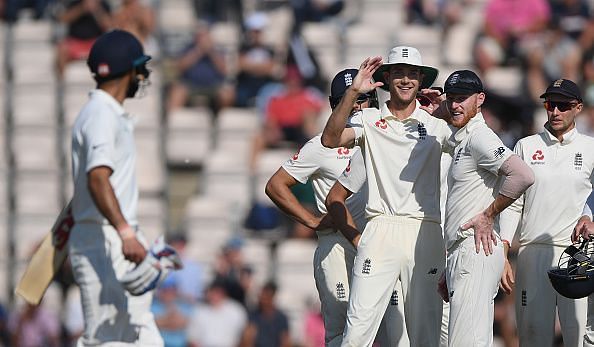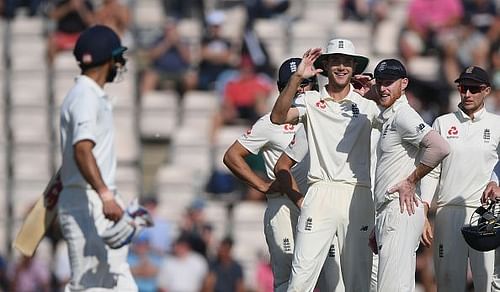
A review of India's Test series loss in England and South Africa

So close, yet so far! That’s how an Indian fan would probably look back at the two Test matches that India lost during the England series, the one in Edgbaston and the one in Southampton a day back.
It was said, learning lessons from the past tours would help a team rectify its mistakes and make them prepare for the future tours. Did India learn lessons from its recent tour to South Africa? If yes, where did it go wrong in England? What is the way out? Let’s find out.
Batting worries
It was another disappointing performance by the Indian batting unit that has cost them the match at Southampton. Remember, this is not the first time that the team couldn’t chase down a small target after taking control until the fourth day of a Test match.
India’s loss in South Africa in the start of this year (Johannesburg Test) after reducing the opposition in the fourth innings (Target 209 runs) had eventually resulted in India losing the series.
Middle order collapse
If one looks at the last few series played in foreign conditions, one gets an impression that the run chases fell flat when a wicket fell after a promising partnership. You are right, the wickets kept trembling from then on!
This series was not an exception either. India’s consistency with the changing lineup also has a role in this situation. Nobody really knows who will bat at number 6, 7 and 8. This is coming at a time when the England lower-middle order continues to play some quality cricket to keep their team in contention during various stages of the Test series.
Overreliance on Virat Kohli
There was a time when India used to depend heavily on Sachin Tendulkar and his departure being symbolized by India’s loss in the match. If present trends are to be noted, this team appears to be in the same track.
Take for example the Edgbaston Test where Virat scored almost 50 percent of what the team had scored in the match. Barring Australia’s tour to India last year, the Indian captain has been the top performer in every Test series that he has been a part of and has been shattering many records.
It is true that the likes of Pujara and Rahane have stepped up at times, but they are fairly inconsistent in terms of form and there is no assurance of them playing well after the fall of the Indian captain.
If India needs to win games abroad, the team effort is the only factor that can help them achieve the same.
Winning critical moments
In the Edgbaston and Southampton Tests, India had the upper hand after removing the top six batsmen cheaply but gave away runs to the English tail, who, along with Sam Curran and Butler, dashed India's hopes to the match.
In the South African tour, the likes of Rabada and Keshav Maharaj scored crucial runs with their top order batsmen and when we look at the game overall, it was evident that these runs definitely made a difference in the outcome of the match.
If Indian bowling is good enough to dismiss the top six, why is it struggling against the remaining players again and again?
Chopping and changing policy
No one other than Virat Kohli is assured of a place in the Test lineup. The fact that India isn’t playing with a settled eleven is putting pressure on its players, which is seldom understood though not stated by anyone.
Team management picks players based on the condition of the wicket and at times good players don’t get a chance to play at all. We saw this in South Africa where Bhuvneshwar and Rahane were not part of the eleven.
In England, Ravindra Jadeja was overlooked and Kuldeep Yadav got the nod ahead of him, despite Jadeja being the number two spinner. What is it that the team management is intending to convey?
Had it been Jadeja, he could have added some depth to the batting and his past records in England suggest that he can do well in English conditions. We also saw Moeen Ali, a player similar to Jadeja doing extremely well in the fourth Test.
If you look at Tests, it is evident that all the great teams have had a settled lineup and players never had to worry so much about their place in the eleven.
Slow batting
Indian batsmen never looked comfortable in England and South Africa. At several times, they were scoring runs at less than two runs per over. If a team is not scoring runs, it gives an advantage to the bowling team as they can deploy a more aggressive field setting without bothering much about the flow of runs.
It is logical to think that Pujara and Vijay at times were overlooked for their slow approach in batting. Aggressive batting isn’t always about scoring runs in every ball, but to make a point that they are here to make runs.
Wicketkeepers failing with the bat
When was the last time you saw an Indian wicketkeeper scoring at least 40 runs in a Test match? In the absence of Wriddhiman Saha; India have tried Dinesh Karthik, Parthiv Patel, and Rishabh Pant, but none of them made any notable contributions with the bat after playing in so many matches.
Since the team can afford only five batsmen in foreign conditions, the contributions made by their wicketkeeper does matter a lot. Perhaps it is time these players work more on their batting skills in addition to keeping responsibilities.
What's next?
Skipper Virat Kohli rightly said in the post-match presentation that the team has been able to create chances in many matches but would not have been able to capitalize on them to the fullest.
Isn't this the same issue that led to India losing the series in South Africa? It is high time the team and its players learn from their mistakes to change their fate in the next tour which is against Australia by the end of this year.